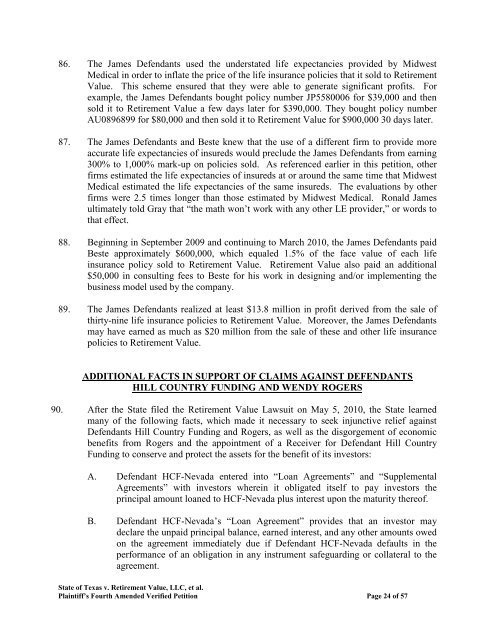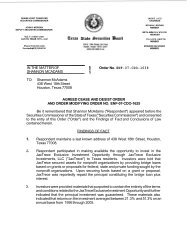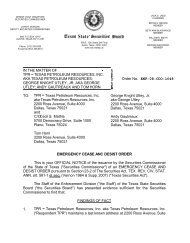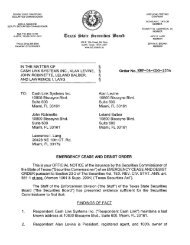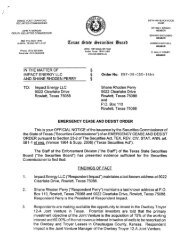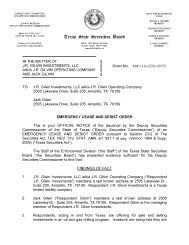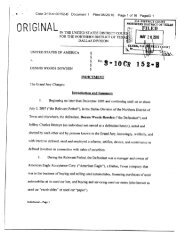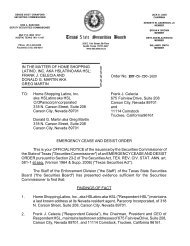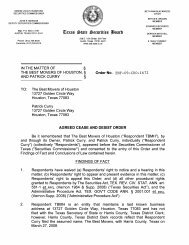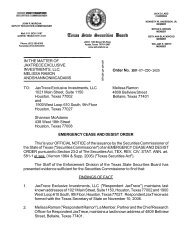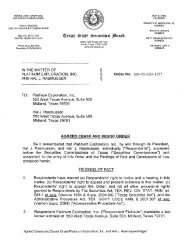Plaintiffs Fourth Amended Petition - Texas State Securities Board
Plaintiffs Fourth Amended Petition - Texas State Securities Board
Plaintiffs Fourth Amended Petition - Texas State Securities Board
You also want an ePaper? Increase the reach of your titles
YUMPU automatically turns print PDFs into web optimized ePapers that Google loves.
86. The James Defendants used the understated life expectancies provided by Midwest<br />
Medical in order to inflate the price of the life insurance policies that it sold to Retirement<br />
Value. This scheme ensured that they were able to generate significant profits. For<br />
example, the James Defendants bought policy number JP5580006 for $39,000 and then<br />
sold it to Retirement Value a few days later for $390,000. They bought policy number<br />
AU0896899 for $80,000 and then sold it to Retirement Value for $900,000 30 days later.<br />
87. The James Defendants and Beste knew that the use of a different firm to provide more<br />
accurate life expectancies of insureds would preclude the James Defendants from earning<br />
300% to 1,000% mark-up on policies sold. As referenced earlier in this petition, other<br />
firms estimated the life expectancies of insureds at or around the same time that Midwest<br />
Medical estimated the life expectancies of the same insureds. The evaluations by other<br />
firms were 2.5 times longer than those estimated by Midwest Medical. Ronald James<br />
ultimately told Gray that “the math won’t work with any other LE provider,” or words to<br />
that effect.<br />
88. Beginning in September 2009 and continuing to March 2010, the James Defendants paid<br />
Beste approximately $600,000, which equaled 1.5% of the face value of each life<br />
insurance policy sold to Retirement Value. Retirement Value also paid an additional<br />
$50,000 in consulting fees to Beste for his work in designing and/or implementing the<br />
business model used by the company.<br />
89. The James Defendants realized at least $13.8 million in profit derived from the sale of<br />
thirty-nine life insurance policies to Retirement Value. Moreover, the James Defendants<br />
may have earned as much as $20 million from the sale of these and other life insurance<br />
policies to Retirement Value.<br />
ADDITIONAL FACTS IN SUPPORT OF CLAIMS AGAINST DEFENDANTS<br />
HILL COUNTRY FUNDING AND WENDY ROGERS<br />
90. After the <strong>State</strong> filed the Retirement Value Lawsuit on May 5, 2010, the <strong>State</strong> learned<br />
many of the following facts, which made it necessary to seek injunctive relief against<br />
Defendants Hill Country Funding and Rogers, as well as the disgorgement of economic<br />
benefits from Rogers and the appointment of a Receiver for Defendant Hill Country<br />
Funding to conserve and protect the assets for the benefit of its investors:<br />
A. Defendant HCF-Nevada entered into “Loan Agreements” and “Supplemental<br />
Agreements” with investors wherein it obligated itself to pay investors the<br />
principal amount loaned to HCF-Nevada plus interest upon the maturity thereof.<br />
B. Defendant HCF-Nevada’s “Loan Agreement” provides that an investor may<br />
declare the unpaid principal balance, earned interest, and any other amounts owed<br />
on the agreement immediately due if Defendant HCF-Nevada defaults in the<br />
performance of an obligation in any instrument safeguarding or collateral to the<br />
agreement.<br />
<strong>State</strong> of <strong>Texas</strong> v. Retirement Value, LLC, et al.<br />
Plaintiff’s <strong>Fourth</strong> <strong>Amended</strong> Verified <strong>Petition</strong> Page 24 of 57


